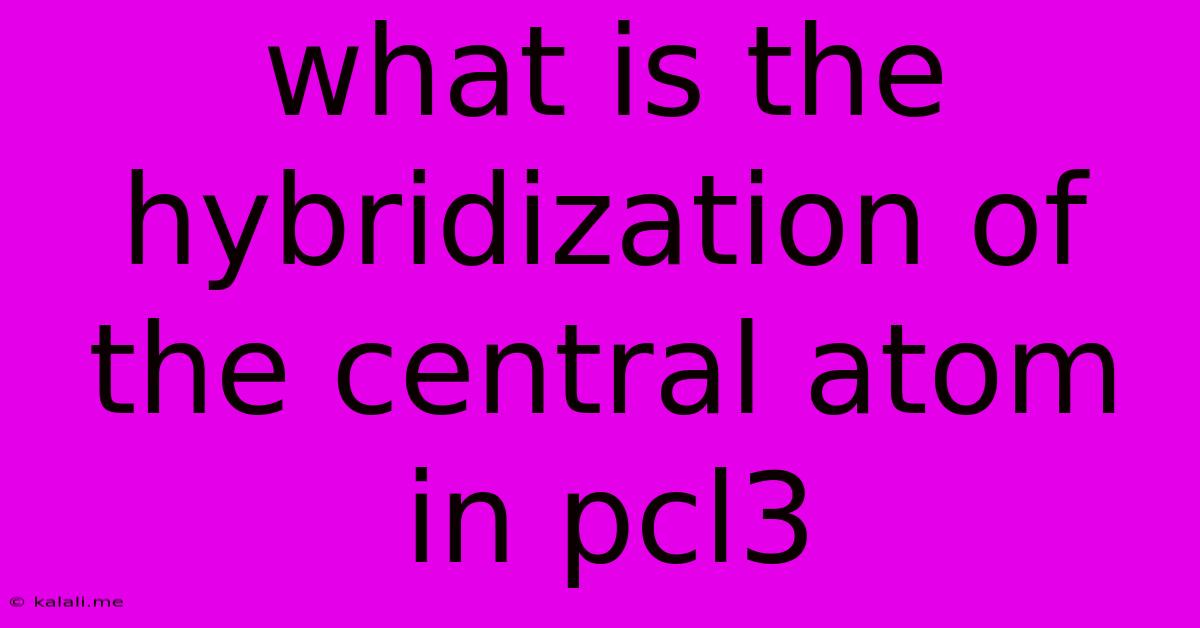What Is The Hybridization Of The Central Atom In Pcl3
Kalali
Jun 14, 2025 · 2 min read

Table of Contents
What is the Hybridization of the Central Atom in PCl₃?
Understanding the hybridization of the central atom in phosphorus trichloride (PCl₃) is crucial for grasping its molecular geometry and properties. This article will delve into the process of determining the hybridization, explaining the concept clearly and concisely. Learn how to apply VSEPR theory and understand the significance of this crucial aspect of PCl₃'s structure.
The central atom in PCl₃ is phosphorus (P). To determine its hybridization, we need to consider the number of sigma bonds and lone pairs around the phosphorus atom. This is achieved using Valence Shell Electron Pair Repulsion (VSEPR) theory.
Understanding VSEPR Theory and its Application to PCl₃
VSEPR theory predicts the geometry of molecules based on the repulsion between electron pairs in the valence shell of the central atom. These electron pairs can be either bonding pairs (involved in sigma bonds) or lone pairs (non-bonding electrons).
Phosphorus (P) is in group 15 of the periodic table, meaning it has 5 valence electrons. In PCl₃, phosphorus forms three single covalent bonds with three chlorine (Cl) atoms. Each single bond involves one sigma bond. This accounts for three of phosphorus's valence electrons. The remaining two valence electrons exist as a lone pair on the phosphorus atom.
Therefore:
- Number of sigma bonds: 3
- Number of lone pairs: 1
The total number of electron domains (sigma bonds + lone pairs) around the phosphorus atom is 3 + 1 = 4.
Determining the Hybridization
The number of electron domains corresponds directly to the number of hybrid orbitals needed. Four electron domains require four hybrid orbitals. This corresponds to sp³ hybridization.
In sp³ hybridization, one s orbital and three p orbitals combine to form four equivalent sp³ hybrid orbitals. These hybrid orbitals are arranged tetrahedrally around the central phosphorus atom. Three of these sp³ orbitals overlap with the 3p orbitals of the three chlorine atoms, forming three sigma bonds. The fourth sp³ hybrid orbital accommodates the lone pair of electrons on the phosphorus atom.
Molecular Geometry of PCl₃
While the electron-domain geometry is tetrahedral (due to the four electron domains), the molecular geometry (considering only the positions of the atoms) is trigonal pyramidal. This is because the lone pair exerts a stronger repulsive force than the bonding pairs, pushing the chlorine atoms closer together.
Conclusion
In summary, the hybridization of the central phosphorus atom in PCl₃ is sp³. This hybridization arises from the presence of three sigma bonds and one lone pair of electrons around the phosphorus atom, resulting in a trigonal pyramidal molecular geometry. Understanding hybridization is key to predicting molecular shapes and properties, crucial for various applications in chemistry.
Latest Posts
Latest Posts
-
Least Common Multiple Of 60 And 72
Jun 15, 2025
-
What Is The Unit Of The Coefficient Of Friction
Jun 15, 2025
-
Is Milk Of Magnesia Acidic Or Basic
Jun 15, 2025
-
Which Of The Following Is Not A Consumer
Jun 15, 2025
-
Which Of The Following Is Not An Optical Storage Device
Jun 15, 2025
Related Post
Thank you for visiting our website which covers about What Is The Hybridization Of The Central Atom In Pcl3 . We hope the information provided has been useful to you. Feel free to contact us if you have any questions or need further assistance. See you next time and don't miss to bookmark.